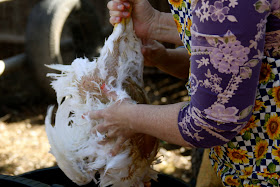While I've raised layers for about three years, this weekend was the first time I was able to participate in learning how to slaughter meat chickens. And I'm happy to report it was a great experience! My friend, Debbie, is an excellent teacher, very patient and good at explaining things.
For the faint of heart, I've been careful in selecting only certain pictures to show the process, but this is a homesteading blog, girls!
We processed 8 Cornish cross chickens (the white chickens) in about 2 1/2 - 3 hours since everything was already set up. You can see them here along with some layers that Debbie was raising before introducing them into her existing flock. Cornish Cross are the most commonly raised meat birds, gaining an exceptional amount of weight in an 8 week period. You don't want to go beyond the 8 week period because they begin to get too heavy (they stop walking around) and they begin developing pin feathers.
I'm sparing you the beheadings and going straight to the scalding, but trust me... we all took a turn. (My husband did not think it would be appropriate to post too much blood and gore). However, you can see Debbie draining the blood from the bird.
Anyway, after we removed the head and drained it, we dunked the bird up to its feet in a hot water bath. This helps you to remove the feathers easily. (Notice Debbie's painted nails and jewelry - she's a TRUE Southern Belle; a real Steel Magnolia!)
Next comes the plucking; and if you've done the water bath just right, the feathers come off easily without tearing or scalding the skin. There's an art to this. Debbie says when the steam starts to smell like chicken soup, pull her out!
A quick rinse will show you what you left behind. We didn't use a pin knife, but this tool can help you get any remaining feather pins if necessary. Debbie has skill... no need for fancy tools here!
Now it was time to remove the feet which she's saving for good chicken broth (right, Wardeh!)...
And cutting under the breast to open up the cavity a bit allows you to remove the heart and liver which are saved as well. (Some things just have to be done by hand!)
Then you can remove the rest of the internal organs and discard them...
Almost done... cut off the tail and remove the vent by cutting just under it and in a v-shape up to the cavity that is already cut open. (This is all discarded as well.)
And finally, the neck is removed and saved for broth along with the feet. At this point, you can keep the bird whole or cut it up however you're family prefers.
I was really proud of my oldest daughter who joined me for the morning. I want my girls to learn these things early on so that it is a way of life. She's interested in food science and possibly culinary arts, so I'm sure Julia Child would be proud of her, too!
In the end, it was a great morning getting a lot done, made even better by sharing it with friends. I think this is how it should be. Thanks, Debbie! I can't wait to get started raising my own!
To learn more about raising meat chickens, you might want to read this article from Mother Earth News which will introduce you to the subject.














































